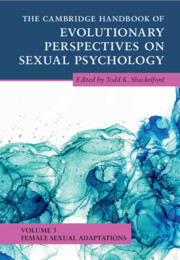Book contents
- The Cambridge Handbook of Evolutionary Perspectives on Sexual Psychology
- The Cambridge Handbook of Evolutionary Perspectives on Sexual Psychology
- Copyright page
- Contents
- Contributors
- Preface
- Part I Precopulatory Adaptations
- Part II Copulatory Adaptations
- Part III Postcopulatory Adaptations
- 13 Mate Retention
- 14 Shifts in Partner Attractiveness
- 15 Emotional Commitment
- 16 Female Sexual Jealousy
- 17 On Attachment and Evolution: Recounting the Story of, and Stories in, Attachment Theory
- 18 Maternal Filicide
- Index
- References
15 - Emotional Commitment
from Part III - Postcopulatory Adaptations
Published online by Cambridge University Press: 30 June 2022
- The Cambridge Handbook of Evolutionary Perspectives on Sexual Psychology
- The Cambridge Handbook of Evolutionary Perspectives on Sexual Psychology
- Copyright page
- Contents
- Contributors
- Preface
- Part I Precopulatory Adaptations
- Part II Copulatory Adaptations
- Part III Postcopulatory Adaptations
- 13 Mate Retention
- 14 Shifts in Partner Attractiveness
- 15 Emotional Commitment
- 16 Female Sexual Jealousy
- 17 On Attachment and Evolution: Recounting the Story of, and Stories in, Attachment Theory
- 18 Maternal Filicide
- Index
- References
Summary
A commitment ensures I forsake other options and allows another to make predictions about my future actions. Emotions are physiological and psychological experiences that serve a survival function by motivating our behavior. From an evolutionary psychological perspective, an emotional commitment is a mating strategy with a psychological, physiological, and behavioral milieu naturally selected to forge an ensuring partnership with short-term sacrifices for long-term gains. Using Dawkins’ concept of genesmanship, people have the predisposition to commit to another because this long-term alliance will increase the likelihood of passing on their own genetic legacy. Women and men faced differing reproductive issues over the course of human evolution, and through sexual selection, the sexes have developed competing mating strategies to solve problems of maximizing fitness. Women have far fewer reproductive opportunities and far more substantial childbearing and childrearing costs compared to men, and therefore making a an emotional commitment to a man, and securing one from him in return, would have allowed for a better chance of offspring survival in the environment of evolutionary adaptedness (EEA) by access to provisioning and protection. With our minds still operating today as they did over the course of millions of years of human existence, women world-wide still seek emotional commitment to a greater extent than men. In this chapter, I discuss the nature of emotional commitment, and the significance of love, romance, and marriage. Moreover, emotional commitment to others (nonromantic partners) also serves a survival function. I therefore also discuss emotional commitment to kin (parent-child attachment, other family) and to non-kin (friends, pets).
- Type
- Chapter
- Information
- Publisher: Cambridge University PressPrint publication year: 2022
References
- 2
- Cited by



